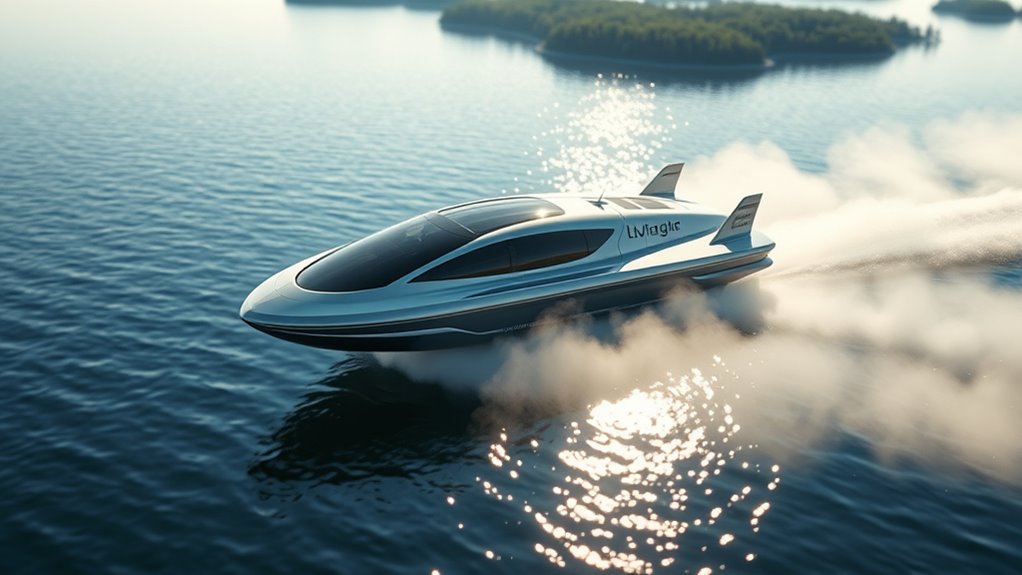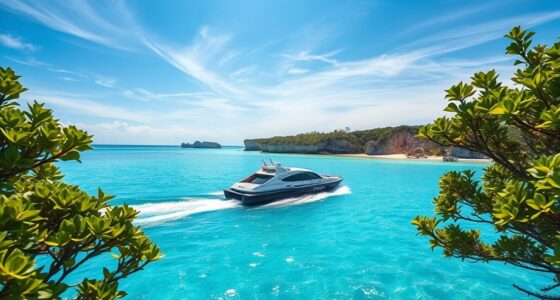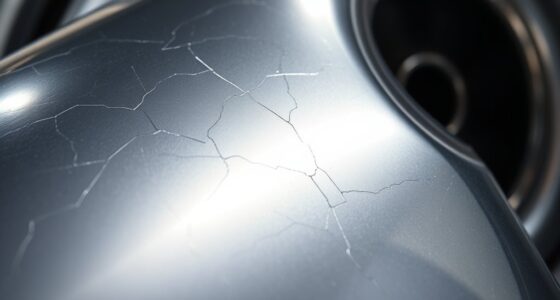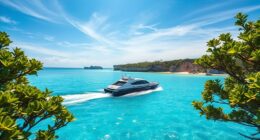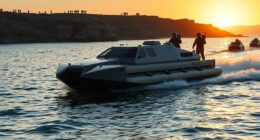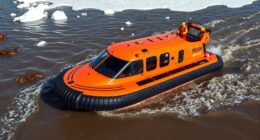A hybrid hovercraft combines air cushion and foil systems, allowing you to glide effortlessly over both land and water. This innovative design enhances versatility, making navigation smooth even in challenging terrains. You’ll enjoy the benefits of advanced propulsion options, including eco-friendly engines, for better sustainability. With various market applications, from search and rescue operations to tourism, this technology is revolutionizing transportation. Explore further to discover more about its exciting potential and future developments.
Key Takeaways
- Hybrid hovercraft utilize both air cushion and foil systems, enabling seamless navigation over land and water terrains.
- The design focuses on balancing lift from air cushions and foils for optimal stability and efficiency.
- Advanced propulsion systems allow for efficient mode switching between land and water, enhancing operational versatility.
- Eco-friendly propulsion options are being explored to improve sustainability and market appeal in hybrid hovercraft technology.
- These vehicles have diverse applications, including search and rescue, goods transportation, and tourism, revolutionizing multi-terrain transport.

Have you ever wondered how a vehicle can seamlessly glide over both land and water? That’s the magic of hybrid hovercraft, combining air cushion and foil systems to create a unique mode of transportation. These vehicles don’t just float; they harness the power of air and water, allowing them to navigate diverse terrains. As you explore more into the world of hybrid hovercraft, you’ll discover the intricate design challenges engineers face to bring this innovative concept to life.
One of the primary design challenges lies in balancing the air cushion and foil systems. The air cushion provides lift, while the foils generate lift when the vehicle picks up speed. Achieving the right mix is essential; if one system overpowers the other, the hovercraft may struggle to maintain stability or efficiency. Engineers work tirelessly to optimize the shape and size of the hull, ensuring it can handle both environments without compromising performance. You might be surprised to learn that even minor adjustments in design can greatly impact the hovercraft’s ability to glide smoothly over water or traverse uneven terrain.
Balancing air cushion and foil systems is crucial for hybrid hovercraft stability and performance. Even small design tweaks can make a significant difference.
Another challenge is the propulsion system. Hybrid hovercraft need to be versatile enough to switch between different modes of operation, whether cruising over land or speeding across water. This requires advanced engineering to create a propulsion system that’s both powerful and adaptable. If you’re thinking about the environmental impact, you’ll be pleased to know that many manufacturers are exploring eco-friendly options, like electric or hybrid engines. This shift not only addresses sustainability but also opens up new market applications for these versatile vehicles. The use of energy-efficient technologies in design can further enhance their appeal and sustainability.
Speaking of market applications, hybrid hovercraft have immense potential across various industries. Imagine using them for search and rescue missions in remote areas or for transporting goods to hard-to-reach locations. They can even serve in tourism, offering unique experiences as they glide over picturesque landscapes. As you explore these possibilities, you’ll see how hybrid hovercraft can revolutionize transportation in ways we’ve only begun to imagine.
Frequently Asked Questions
What Are the Main Advantages of Hybrid Hovercraft Over Traditional Vessels?
Hybrid hovercraft offer you design innovation and cost efficiency that traditional vessels can’t match. You’ll enjoy greater versatility in maneuvering various terrains, allowing for operations in areas where conventional ships struggle. Their streamlined design reduces drag, leading to fuel savings and lower operational costs. Plus, the ability to shift between land and water seamlessly minimizes the need for multiple craft, saving you both time and money in your transportation needs.
How Do Hybrid Hovercraft Perform in Different Weather Conditions?
Hybrid hovercraft thrive in challenging weather conditions like champions in a storm! Their weather resilience allows you to navigate through rough seas and strong winds with remarkable stability. Unlike traditional vessels, you’ll experience minimal performance variability, ensuring you reach your destination without a hitch. Whether it’s choppy waves or gusty winds, these hovercraft adapt effortlessly, making your journey smoother and more reliable than ever. You won’t believe how well they handle the elements!
What Maintenance Is Required for Hybrid Hovercraft Systems?
To keep hybrid hovercraft systems running smoothly, you’ll need to follow regular maintenance protocols. Inspect the air cushion and foil components for wear and tear, ensuring their durability. Check the propulsion and steering systems frequently, as they’re essential for performance. Lubricate moving parts and replace any damaged components promptly. By staying on top of these tasks, you’ll enhance the longevity and reliability of your hovercraft, ensuring it performs well in various conditions.
Can Hybrid Hovercraft Be Used for Passenger Transport?
Yes, hybrid hovercraft can be used for passenger transport. They offer impressive passenger capacity, accommodating a significant number of travelers comfortably. Plus, their unique design provides route flexibility, allowing them to navigate various terrains and water bodies with ease. This flexibility makes them ideal for connecting remote locations or providing services in areas where traditional transport isn’t feasible. You’ll find them an innovative solution for modern passenger transport needs.
What Is the Typical Lifespan of a Hybrid Hovercraft?
A hybrid hovercraft typically boasts a lifespan of 20 to 30 years, gliding smoothly over water and land like a bird in flight. When you consider durability factors like maintenance, usage intensity, and environmental conditions, you can better project its lifespan. Regular upkeep ensures it remains a reliable vessel, while harsh conditions might shorten its time on the water. With proper care, you’ll enjoy many years of efficient transport.
Conclusion
In conclusion, hybrid hovercraft hold incredible potential, blending buoyant brilliance with sleek, soaring systems. They not only navigate various terrains with ease but also promise a more efficient, eco-friendly future. As technology takes flight, these fantastic vessels will redefine recreational and commercial travel, transforming the way we traverse our world. So, whether you’re gliding over water or flying across flatlands, embrace the innovation and excitement that hybrid hovercraft bring to your adventures!

